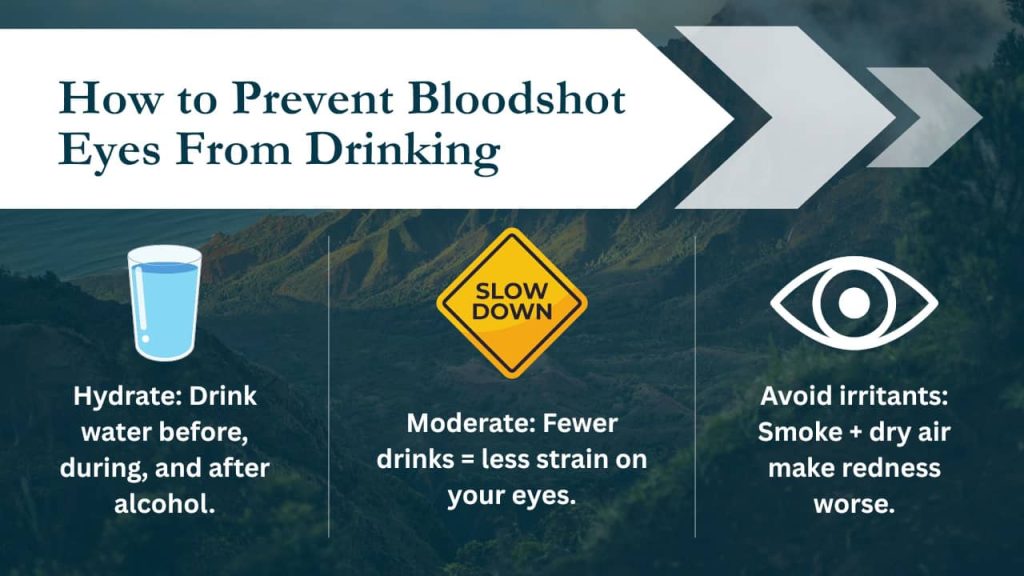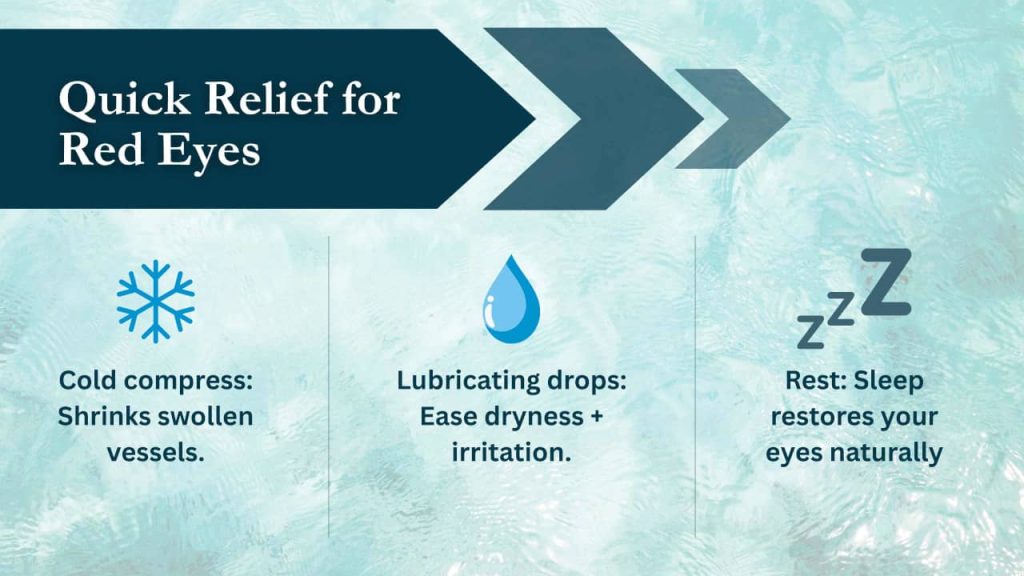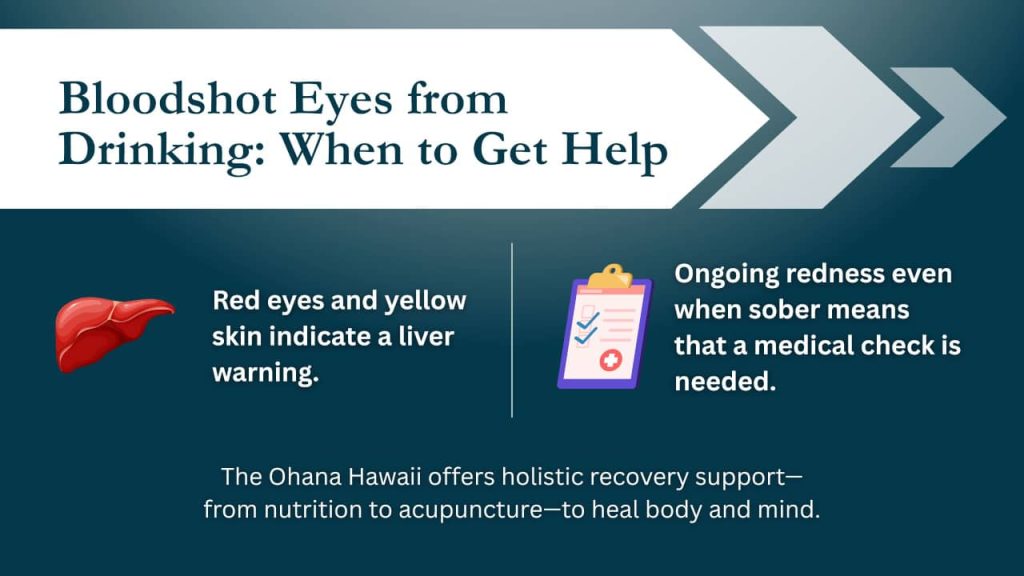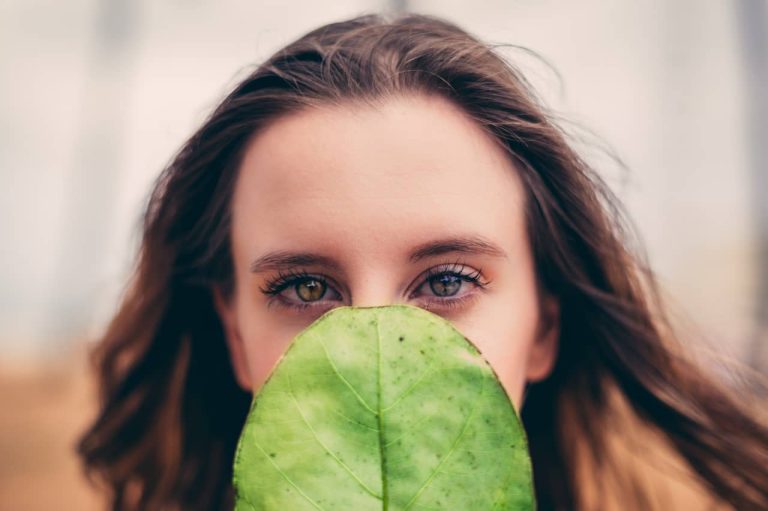Bloodshot Eyes After Drinking Alcohol: Causes & When to Worry
If you’ve ever looked in the mirror after a night of drinking and noticed red, irritated eyes staring back at you, you’re not alone. Bloodshot eyes after drinking alcohol are a common complaint, but they can mean different things depending on the situation. For some, the redness is a short-lived nuisance caused by dehydration or irritation. For others, recurring bloodshot eyes may point to deeper health issues—or even signal alcohol dependence.
In this guide, we’ll explore why alcohol and bloodshot eyes are so closely linked, when to take symptoms seriously, and how recovery programs like The Ohana Hawaii’s evidence-based and holistic treatments help address not just the surface symptoms, but the underlying patterns of alcohol use that cause them.
Alcohol and Bloodshot Eyes
Why Do My Eyes Get Red When I Drink?
Alcohol is a vasodilator, which means it causes blood vessels to expand. In your eyes, those dilated vessels become more visible, leading to the telltale redness. Dehydration from alcohol also contributes by drying out the eyes, causing irritation.
Other contributing factors include:
Dehydration
Alcohol works as a diuretic, pulling water from your body and reducing tear production. With less moisture, eyes dry out, look dull, and become more prone to redness and irritation. Staying hydrated before, during, and after drinking can help, though for people with alcohol use disorder the dehydration cycle can become chronic and harder to break.
Irritation
Alcohol also triggers inflammation in delicate eye tissue, leaving eyes more sensitive to allergens, smoke, and environmental irritants. This ongoing irritation in frequent drinkers can cause persistent redness, dryness, or burning sensations. Holistic recovery programs like The Ohana Hawaii’s focus on nutrition and lifestyle changes that calm inflammation and support healthier eyes.
Sleep Disruption
Alcohol disrupts normal sleep cycles, especially REM sleep, which is essential for cell repair. Without enough restorative rest, tiny eye vessels stay dilated and fluid pools in surrounding tissue, creating puffiness and redness. At our Hawaii rehab center, clients learn healthy sleep habits as part of recovery plans so their bodies — and their eyes — can heal faster.
For most people, this redness fades after the alcohol leaves the system. But recurring bloodshot eyes from drinking may signal a bigger issue.
Are Red Eyes After Drinking Alcohol Normal or a Warning Sign?
Occasional red eyes after alcohol may not be cause for alarm. But persistent or frequent bloodshot eyes after alcohol use can signal underlying health concerns, including high blood pressure, liver damage, or even early signs of alcohol use disorder.
Are Bloodshot Eyes a Sign of Alcoholism?
Not always—but they can be. Bloodshot eyes alcohol symptoms often appear in heavy or chronic drinkers because of repeated strain on the liver and cardiovascular system. Over time, alcoholism bloodshot eyes are linked with other visible signs, such as facial puffiness, broken blood vessels in the skin, and yellowing of the eyes from liver damage.
Many people even worry they have an “alcoholic face” when they notice these changes, but it’s important to remember this isn’t a medical term. What people describe as an alcoholic face is usually a combination of factors like chronic puffiness, redness, and skin changes from long-term drinking—and with the right help, many of these signs can improve as your body heals.
If you find yourself asking “does alcohol cause bloodshot eyes every time I drink?” or “are my red eyes from alcohol normal?”, it may be worth evaluating your drinking habits more closely. Treatment centers like The Ohana emphasize that alcohol-related physical symptoms are often the body’s first cry for help.
How to Prevent Bloodshot Eyes From Drinking
While the only foolproof way to prevent bloodshot eyes after alcohol is to avoid drinking, there are ways to minimize symptoms:
Drink plenty of water before, during, and after alcohol use
Alcohol is dehydrating, which means your eyes (and the rest of your body) lose essential moisture quickly. Drinking water regularly while consuming alcohol helps your system flush toxins more efficiently and keeps the eyes lubricated. Staying hydrated also reduces the severity of hangover-related redness the next day.
Avoid smoke, dry air, or environments that irritate the eyes
Bars, clubs, and parties often expose you to secondhand smoke or dry indoor air that already strain your eyes. When combined with alcohol, these irritants can make redness worse. Choosing a well-ventilated space or stepping outside for breaks can help minimize the damage.
Limit salty foods that dehydrate the body further
Salty snacks like chips, pretzels, or bar food intensify alcohol’s dehydrating effect, which can leave your eyes even drier. By reducing sodium intake while drinking, you help your body retain more fluid and protect the delicate tissues in your eyes. Pairing alcohol with water-rich foods like fruit or vegetables is a better choice.
Practice moderation if you choose to drink at all
Even small adjustments in how much you drink can make a big difference in how your body and eyes respond. Sticking to moderate drinking guidelines lowers the chance of bloodshot eyes while also protecting long-term liver and cardiovascular health. For individuals in recovery, abstaining entirely is the safest option.

What Actually Helps Alcohol-Related Bloodshot Eyes
If you already have red eyes after drinking alcohol, simple remedies can help:
Hydration: Replenish fluids with water or electrolyte drinks
Flushing your system with water helps your body recover faster from dehydration. Adding electrolytes can speed up rebalancing and restore moisture to the eyes more quickly.
Artificial tears: Over-the-counter lubricating drops ease dryness
Eye drops restore the tear film that alcohol depletes, soothing irritation and minimizing redness. Consistent use can also help prevent lingering discomfort the next morning.
Cold compress: Placing a cool cloth over closed eyes can constrict blood vessels and reduce redness
The cold temperature calms inflammation and shrinks dilated vessels that give eyes their bloodshot appearance. It also provides instant relief from the burning or itching sensation many people feel after drinking.
Rest: A good night’s sleep helps restore your body and your eyes
Alcohol disrupts normal sleep cycles, so allowing yourself to fully recover with adequate rest is essential. Sleep repairs cell damage, reduces inflammation, and allows your eyes to return to their normal state.

At The Ohana Hawaii, clients recovering from alcohol use also benefit from holistic treatments like nutrition counseling, acupuncture, yoga, and massage—all of which support circulation, reduce inflammation, and promote overall healing, including eye health.
What Not to Do: Viral “Remedies” to Skip
Internet myths abound when it comes to treating red eyes from alcohol, but some popular remedies can actually make things worse.
No Baking Soda, Vinegar, or DIY Eye Baths
Household items are not meant for your eyes. Substances like vinegar or baking soda are highly irritating and dangerous when used near delicate eye tissue.
Why Non-Sterile Rinses Increase Risk of Infection and Irritation
Using tap water, herbal concoctions, or unclean rinses can introduce bacteria into the eye. Instead, stick with sterile artificial tears recommended by eye doctors.
Persistent Eye Redness and Alcohol Use
If bloodshot eyes continue long after drinking or appear every time you consume alcohol, it could be a red flag. Chronic redness may be connected to:
- Liver damage: Impaired liver function can cause visible changes in the eyes, including jaundice and broken blood vessels.
- High blood pressure: Alcohol raises blood pressure, which stresses the delicate vessels in the eyes.
- Alcohol use disorder: Recurring physical symptoms like red eyes after alcohol often accompany other warning signs of addiction.
When combined with fatigue, yellowing of the eyes, or vision problems, persistent bloodshot eyes should prompt a medical evaluation.
Bloodshot Eyes and Alcohol Withdrawal
Interestingly, bloodshot eyes can also appear during alcohol withdrawal. As the body detoxes, it experiences fluctuations in blood pressure, hydration, and inflammation—all of which can impact the eyes. This is why withdrawal should always be managed under medical supervision, like the medical detox services at The Ohana Hawaii, which keep clients safe and supported through the toughest first days of sobriety.
The Ohana Hawaii: Addressing the Root Causes
At The Ohana, we know bloodshot eyes from drinking are rarely just a cosmetic concern—they’re a visible signal of deeper issues with alcohol use. That’s why our programs don’t just focus on surface-level symptoms but provide comprehensive, evidence-based treatment for alcohol addiction.
Evidence-Based Treatment
Our clinical team uses therapies like CBT (cognitive behavioral therapy) and trauma-informed care to help clients break destructive patterns and address root causes.
Holistic Care
Healing the body and mind go hand-in-hand. Alongside clinical therapy, clients benefit from massage, acupuncture, yoga, art therapy, and sound healing, plus nourishing meals prepared by a private chef.
Adventure-Based Therapy
Located on the Big Island, The Ohana offers kayaking, hiking, and other outdoor experiences that reconnect clients to nature and build resilience in recovery.
When to Worry About Bloodshot Eyes From Alcohol
Red eyes after drinking alcohol are common, but if you notice that redness is:
- Persistent and not going away after rest
- Accompanied by yellowing (jaundice) or vision changes
- Paired with other symptoms of heavy alcohol use
…it’s time to seek help.

Bloodshot eyes may seem minor, but in the context of alcohol use, they can be an important early warning sign. Recognizing them as part of a larger picture of alcohol’s toll on the body is the first step toward change.
When Red Eyes Are More Than Just Irritation
Yes, alcohol can cause bloodshot eyes—but it’s rarely just about irritation. Red, inflamed eyes after drinking are often tied to dehydration, poor sleep, liver strain, and long-term drinking habits.
At The Ohana Hawaii, we see these physical warning signs as opportunities to step back, reflect, and take action. With evidence-based treatment, holistic care, and a compassionate team, we help clients move past temporary symptoms and toward lasting recovery.
If you or someone you love is noticing persistent bloodshot eyes after alcohol use, it may be time to seek help. Call us to begin a healing journey in a safe, supportive environment.













